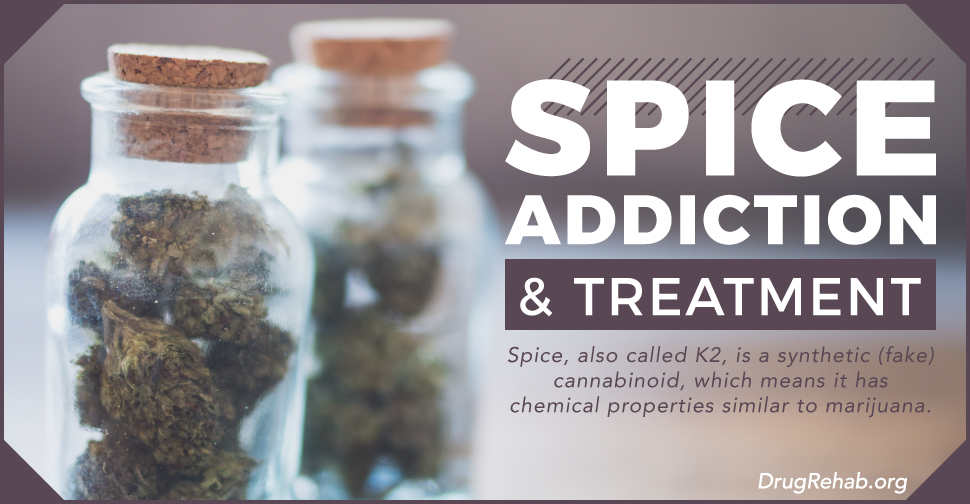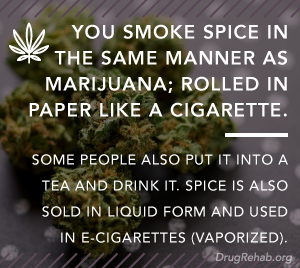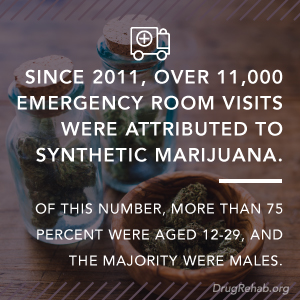
Spice, also called K2, is a synthetic (fake) cannabinoid, which means it has chemical properties similar to marijuana. The National Institute on Drug Abuse for Teens (NIDA) explains that sellers of the drug market it as safe and recreational. But spice is actually quite dangerous due to the risks posed by abuse of it.
Because of this, “Spice is most often labeled ‘Not for Human Consumption’ and disguised as incense” according to the NIDA. While spice may be marketed as similar to marijuana, the drug does not contain the same natural compounds found in marijuana.
With synthetic properties, spice can have adverse, unpredictable effects which can be quite severe, and may even lead to death. Spice addiction can escalate quickly, affect your health, and cause issues in many aspects of your life.
How Is Spice Abused?
You smoke spice in the same manner as marijuana; rolled in paper like a cigarette. Some people also put it into a tea and drink it. Spice is also sold in liquid form and used in e-cigarettes (vaporized).
What Are The Side Effects?
 Spice is fairly new to the drug world, so research on it is limited.What we do know is that it reacts in the brain and body similarly to marijuana, but can be more extreme. Some reported side effects include:
Spice is fairly new to the drug world, so research on it is limited.What we do know is that it reacts in the brain and body similarly to marijuana, but can be more extreme. Some reported side effects include:
- Anxiety
- Confusion
- Paranoia
- Hallucinations
- Improved mood
- Calm, relaxed feeling
- Changes to perception
Some people who experienced severe effects and sought emergency care also had symptoms of increased heart rate, violent behavior, vomiting, and suicidal thoughts. These symptoms can signal overdose, or a buildup of the drug in the body. Overdose can occur from prolonged use, or from too much of a drug during one instance.
Spice affects the body by increasing blood pressure, and slowing the blood flow to the heart. In addition to the risk of overdose, possible long-term effects include kidney damage and seizures.
Other Risks of Spice Addiction
Many of us associate marijuana as a “safe drug.” Whether or not that is true, spice is not the same drug, and it’s important to know the risk potential of it. Spice can cause addiction, and addiction can result in a number of consequences. Just some include negative effects to your health, family, personal life, obligations, and finances.
Addiction can also lead to tolerance. When you have been taking a drug for a period of time, your body can become used to the effects of it—so much that it eventually stops feeling them. If your brain is already used to these effects, though, you’ll experience intense cravings to keep using the drug.
Spice can also cause withdrawal, which means that you’ll experience physical symptoms when not taking it, such as anxiety, feeling depressed, headaches, and irritability.
Who Is Affected?
 Anyone can be affected by drug abuse, but spice has a great impact on teens. As of 2016, “spice is the second-most popular illegal drug used by high school seniors (marijuana is the first)” the NIDA states.
Anyone can be affected by drug abuse, but spice has a great impact on teens. As of 2016, “spice is the second-most popular illegal drug used by high school seniors (marijuana is the first)” the NIDA states.
Since 2011, over 11,000 emergency room visits were attributed to synthetic marijuana. Of this number, more than 75 percent were aged 12-29, and the majority were males.
How Can You Overcome Spice Addiction?
As with any addiction to substances, the key to successful recovery is treatment. You can seek self-treatment, but the care you’ll find at a rehab center provides the support necessary to meet your goals.
Spice addiction can result in withdrawal, so the first step in treatment is detoxification. This process allows your body to flush the toxins built up from abuse. Once you complete this phase, you can begin healing.
Treatment is available through a myriad of methods, but the best plans will be tailored to your needs. Addiction affects the mind, so a big part of healing is rebuilding the confidence and self-esteem necessary to maintain a substance-free life. This can be achieved through Dialectical Behavioral Therapy, which combines motivation and capabilities to help you achieve goals.
Cognitive behavioral therapy teaches you to build entirely new lifestyle habits, replacing the old ones which fostered substance abuse. Counseling can help you give voice to some of the troubling thoughts and emotions that occur during treatment.
These are just some of the evidence-based methods offered at our rehab centers. Whatever treatment path you take, it should be one that addresses not just your health needs, but your individual needs as well.
Reach Out For Treatment Today
Some drugs of abuse present dangerous risks, even with just one use, and spice is one of them. If your teen has been abusing spice, or you know someone who struggles, there is no better time to seek help. We are here to make the process of finding and securing treatment as easy as possible, so you can focus on what’s truly important: healing.
Contact us today at DrugRehab.org to learn more about spice addiction, treatment options, and the best rehab centers available.
For More Information Related to “Spice Addiction And Treatment” Be Sure To Check Out These Additional Resources From DrugRehab.org:
- Synthetic Pot Use On The Rise
- What Is The Difference Between Hashish And Marijuana
- Marijuana Linked to Depression and Schizophrenia
- Cannabis (Marijuana) May Lower The Brain’s Dopamine Levels
- Marijuana And Alcohol Use Increases Odds Of Drunk Driving
- Verbal Memory Harmed By Marijuana Use
- Drug Diversion in Hospitals by Professionals
- The Benefits of Faith-Based Recovery Programs
- How Much Does a Drug and/or Alcohol Intervention Cost?
Sources
Drug Free World—Synthetic Marijuana Long-Term Effects
National Institute On Drug Abuse—DrugFacts: Synthetic Cannabinoids
National Institute On Drug Abuse For Teens—Spice

